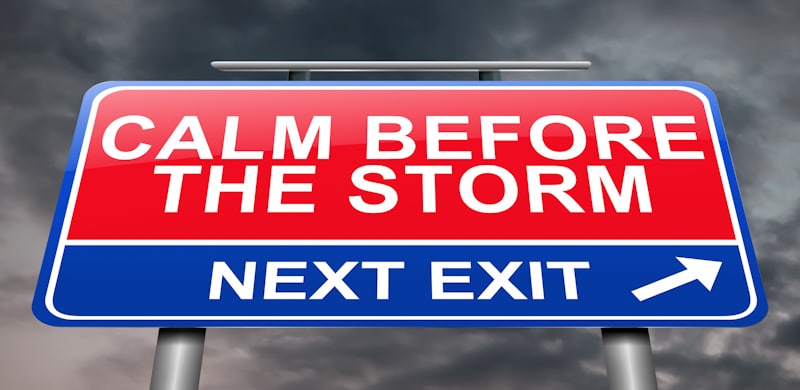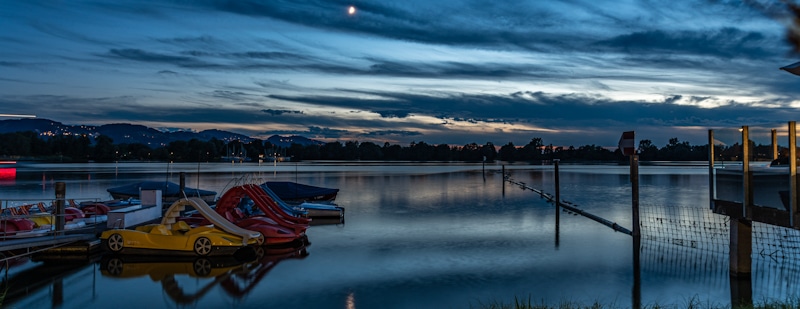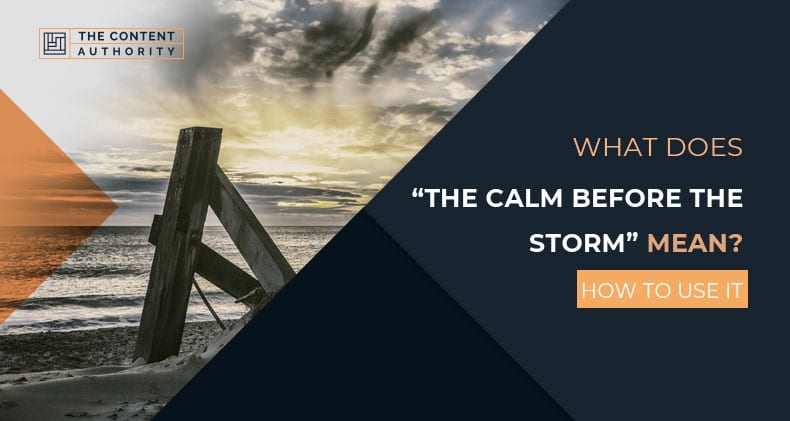Storms are not easy to predict, so are human-made chaos. But a period of quiet is usually a sign something outside of the norm is about to occur – be it an actual storm or confrontation between two individuals or groups. What does all of this have to do with the phrase “the calm before the storm”?
The idiom “the calm before the storm” means “a marked silence before a storm”. Figuratively, it denotes “a period of sanity before things go out of control”. The saying can be used both symbolically and plainly. But the literal usage is not as common, except if you live in a storm-prone region.
The expression is quite commonly used but, as mentioned above, mostly in the figurative sense. If you’re not sure how and when to use the phrase in your sentences, learn more about the origin or how the idiom was conceived in the first place, etc., keep reading.

“The Calm Before the Storm” – Meaning
The idiom “calm before the storm” denotes the “peaceful or quiet phase before a contrasting phase or period during which there’s great commotion”. The “storm” is either anticipated or not expected at all.
Not every period or moment of calm is followed by a storm, however. It’s perfectly alright for a relatively calm situation to not blow up or go out of control. Like the storm that’s not a regular phenomenon, a heated problem after a comparative lull is not the norm.
Phrases or words that are synonymous with/related to or can be used in place of “the calm before the storm” include:
- Quiet before the storm
- Lull before the storm
- Hush before the storm
- The calm before the tempest
- Silence before the storm
- Still before the storm
Phrases that do not use the word “storm” but have a similar meaning are”
- Peace before a crisis
- Period of peace prior to a crisis
- Breath before the plunge
- The peaceful atmosphere before a crisis
- Tranquillity before chaos
Kindly note not all of the phrases mentioned above are recognized or established idioms. Most aren’t. But they can be used in texts. Also, you can concoct your own terms.
Origin of the Phrase “The Calm Before the Storm”
The expression “the calm before the storm” has its backstory, and unsurprisingly, the adage has connections with the sea and sailors. The phrase originates from sailors’ observations of an ocean’s weather becoming uncannily calm before a storm hits.
And it’s not so only at sea. If you observe the weather in your region before an impending storm, the same serenity can be felt.
The birds will stop chirping, the wind won’t blow, there won’t be any downpour (yet), roads will be deserted (likely because everybody watches the news), etc. After a brief moment, the dark clouds shall start to roll in, and things will slowly but surely begin to gather momentum and pace.
The next time a storm announcement is made in your region, look out for these pre-storm indications.
Why Does It Become “Calm” Before the Storm?
Things becoming weirdly quiet right before an imminent storm is no figment of the imagination. There’s scientific reasoning or weather science behind the phenomenon.
A storm is essentially a disturbing environmental state, implying severe weather conditions. For a storm to manifest itself or get fueled, moist, warm air is needed. When a storm approaches, it attracts all air around it, leaving behind a low-pressure vacuum. After that, air rushes through to fill up the void.
The air filling the emptiness is warm but considerably drier compared to the atmosphere that existed before. In other words, the air stabilizes and causes the “lull” or “calm” right before a storm.

Is It Always “Calm Before the Storm”?
No, it’s not. Dropping temperatures, whip-like winds, rumbling thunder, etc., could also at times precede a storm. When the conditions are right (for the storm), a peaceful/eerie calm is most likely. But when the storm has no time to wait, it skips the calm and announces its presence forcefully by unleashing lousy weather.
Using the Phrase “The Calm Before the Storm” in Texts
The expression has been used in texts and various other forms of correspondences for its literal meaning or trope since the 17th century.
In literature, its first-ever mention is believed to be in a play called “The Dumb Knight” in 1601. The following is the line:
- Collaquintida: … but hush, no words; there is calm before the tempest.
“Tempest” means “strong storm”. The idiom became particularly common during the 1800s. And by the early to mid-1900s, the phrase was so extensively used in speech and texts, it was already a cliché.
Unlike most other idioms, there’s not much room for improvisation with “the calm in the storm”. Mostly, it’s used as it is in texts. However, alternate phrases such as “the lull before the storm” could be used instead at times. For example:
- The restaurant is usually not buzzing with activity during breakfast hours. It’s the lull before the storm that forms starting from lunchtime. And once it’s dinner time, the place gets jam-packed.
As mentioned above, the phrase is mainly used metaphorically. But in weather news coverage, the term is almost a given whenever there’s a storm looming.
Does “The Calm Before the Storm” Appear in Print?
Like pretty much every other idiom, “the calm before the storm” is not “formal” language and is unlikely to feature in traditional publications. The phrase could be used in magazines and news websites, but it still may not be used that extensively.
That said, there have been instances of the idiom being used in print in the past. Dig out news articles from the early 1900s, and you may find the term used verbatim or loosely.
Regardless, it’s not recommended to use the phrase in your academic or business texts unless and until you mean it literally, or it’s okay to instill personality into the text.
Example Sentences with “The Calm Before the Storm”
The following is a solid mix of sentences incorporating the phrase “the calm before the storm”:
- There is palpable silence now – the calm before the storm.
- It’s usually the calm before the storm. This time, however, it was the storm before the calm.
- The family is meeting to settle its property disputes. Before the meeting starts, I’ll have my coffee in the calm before the storm.
- This is the calm before the storm. Once the kids are back from school, the house will be nowhere as quiet and peaceful as it is now.
- Do not underestimate the weather here – it’s simply the calm before the storm.
- Things are quite pleasant now, but I suspect it’s the calm before the storm.
- For the lone vagabond, the coming weekend shall be the calm before the storm. He’ll be off on his solo escapades from the following Monday.
- I am thoroughly enjoying my peace right now and don’t want to waste a moment of it because I know it is the calm before the storm.
- I do not feel too bad now, but I am not sure if it’s the calm before the storm or the symptoms will slowly start to show and get worsen with time.
- The air in the office didn’t feel right. It felt like the calm before the storm.
- The region was quiet and peaceful, but unfortunately, it was only the calm before the storm.
- All were able to testify to the conquered tribesmen’s strict obedience, but that was just the calm before the storm.
- The silence that prevailed was the calm before the inevitable storm.
- That tranquil state of the region is uncanny. It’s deceitful. It’s the calm before the storm.
Not to mention, the sentences above can use “lull”, “quiet”, “peace”, etc., instead of “calm” in the phrase.
Can There Be Calm “After” the Storm?
The calm before the storm is not always a given, as explained above. However, calm after a storm or a period of chaos is the next obvious thing to occur because the frenzy or the storm cannot just go on forever. Things have to improve or get better after a chaotic, complicated, or stressful time.
Moreover, there are phrases denoting the same, such as “after a storm comes a calm”, “calm after the storm”, etc. Here are a few sentences incorporating the phrase:
- The bankruptcy process can be an emotionally taxing ride. But remember, there’s always calm after the storm.
- After witnessing the frenzy yesterday, I cannot believe this is the same office. The quietness is striking. A calm indeed comes after a storm.

Conclusion
With all advancements made in meteorology, weather predictions have become a lot more sophisticated. But there still is room for improvement. Advanced computers and their algorithms cannot abort a storm or guarantee zero damage to life and property by a storm always.
Similarly, a tense or frantic scenario is not always preceded by silence or a palpable lull. It’s, however, not rare to see situations go out of hand or turmoil take place just minutes after a period of peace and quietness. Therefore, be wary of things around you.
Shawn Manaher is the founder and CEO of The Content Authority. He’s one part content manager, one part writing ninja organizer, and two parts leader of top content creators. You don’t even want to know what he calls pancakes.

